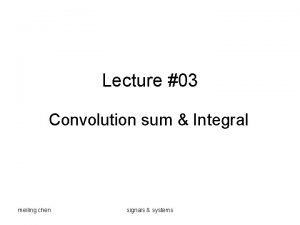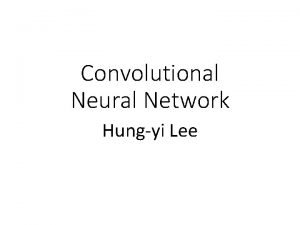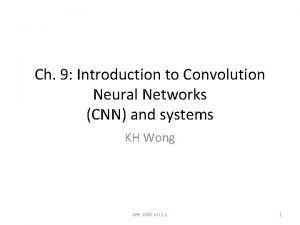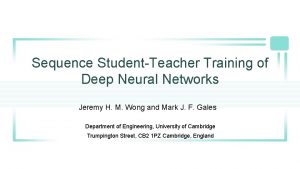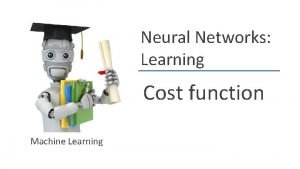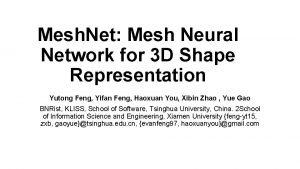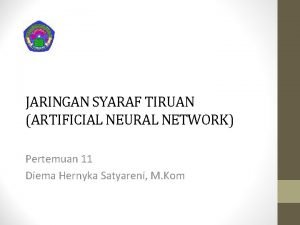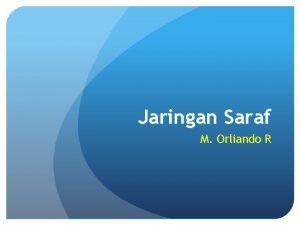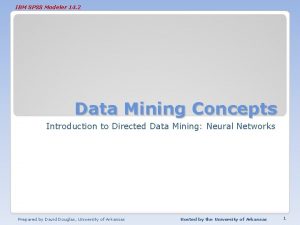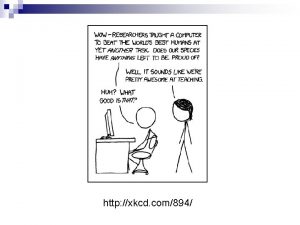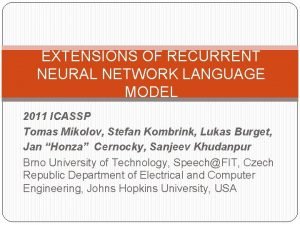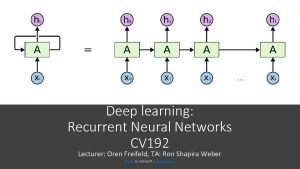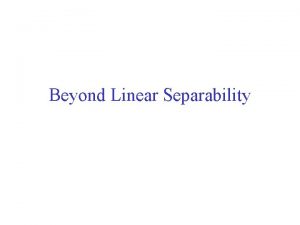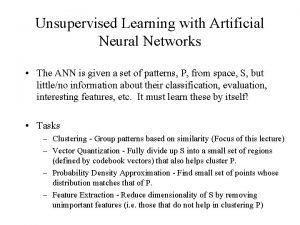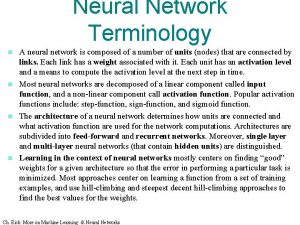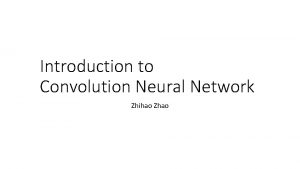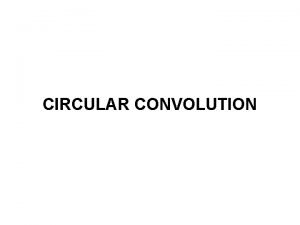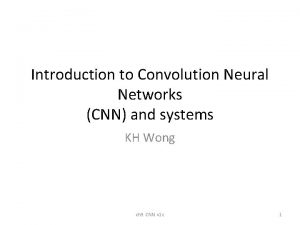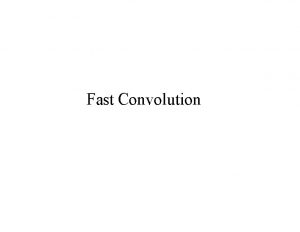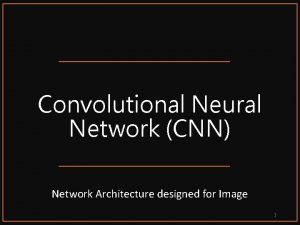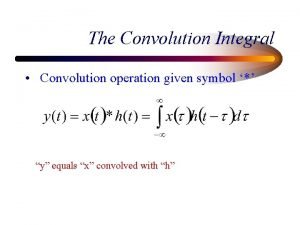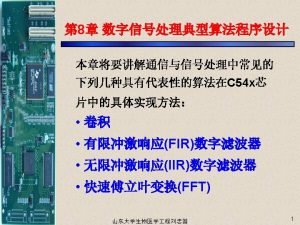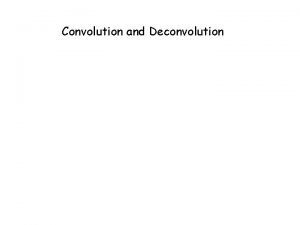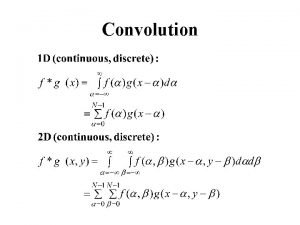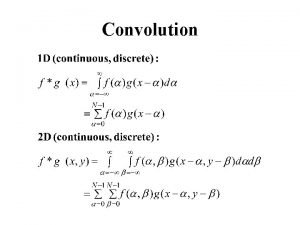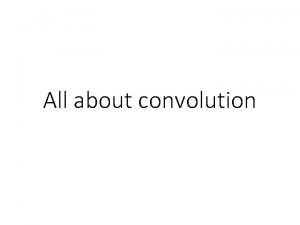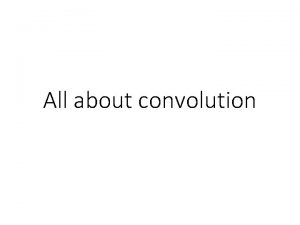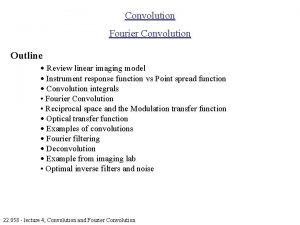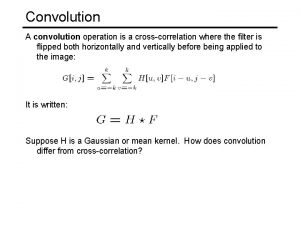Introduction to Convolution Neural Network CNN Xingang Li


























- Slides: 26

Introduction to Convolution Neural Network (CNN) Xingang Li Mechanical Engineering University of Arkansas

Convolution Neural Network (CNN) • CNNs are neural networks with convolutional layers (Conv layers) • CNNs are widely used for image classification and others References: IMECE Paper # 2

MNIST Dataset • “Hello World” problem • 70, 000 images • Handwritten digits 0~9 (10 classes) References: IMECE Paper # 3

MNIST Dataset References: IMECE Paper # 4

A Simple CNN Structure Prediction Loss Div(prediction, label) References: IMECE Paper # 5

A Simple CNN Structure Prediction Loss Div(prediction, label) References: IMECE Paper # 6

Convolution • Conv layers: filters (kernels), 2 D matrices of numbers • We can convolve a filter with an input image 1. Overlay the filter on top of the image at a location, usually top left 2. Performing element-wise multiplication between the values in the filter and their corresponding values in the image 3. Summing up all the element-wise products. This sum is the output value for the destination pixel in the output image. 4. Repeat 1 -3 for all locations. References: https: //victorzhou. com/blog/intro-to-cnns-part-1/ IMECE Paper # 7

Convolution Step 1 : Overlay • The filter values are needed to be initialized at first and will be updated through the training process • Usually starts from top left of an image References: https: //victorzhou. com/blog/intro-to-cnns-part-1/ IMECE Paper # 8

Convolution Step 2 : Element-wise Multiplication References: https: //victorzhou. com/blog/intro-to-cnns-part-1/ IMECE Paper # • Multiply the image value with the filter value in the corresponding position 9

Convolution Step 3 : Sum Up to Destination Pixel • Feature map Sum up References: https: //victorzhou. com/blog/intro-to-cnns-part-1/ IMECE Paper # 10

Stride • How many pixels a filter moves along the image for one step • Length and width directions • Output size = (L – K)/S + 1 • Example: Ø(6 - 2)/1 + 1 = 5 Ø(6 - 2)/2 + 1 = 3 References: http: //makeyourownneuralnetwork. blogspot. com/2020/02/calculating-output-size-of-convolutions. html 11

Convolution Step 4: Repeat • Stride: 1 • Several filters in one Conv layer • Multiple Conv layers in CNN References: https: //victorzhou. com/blog/intro-to-cnns-part-1/ IMECE Paper # 12

Padding input output Output size = (L – K)/S + 1 (6 – 3) + 1 = 4 References: https: //victorzhou. com/blog/intro-to-cnns-part-1/ IMECE Paper # 13

A Simple CNN Structure Prediction Loss Div(prediction, label) References: IMECE Paper # 14

Pooling Feature map (output of a Conv layer) References: https: //victorzhou. com/blog/intro-to-cnns-part-1/ https: //machinelearningmastery. com/pooling-layers-for-convolutional-neural-networks/ • Reduce the size of feature maps • Down-sampling • Max, Average pooling 15

Pooling Feature map (output of a Conv layer) • Example: Max pooling with a pooling size of 2 and a stride of 2 (almost always the case) References: https: //victorzhou. com/blog/intro-to-cnns-part-1/ https: //machinelearningmastery. com/pooling-layers-for-convolutional-neural-networks/ 16

A Simple CNN Structure Prediction Loss Div(prediction, label) References: https: //towardsdatascience. com/mnist-handwritten-digits-classification-using-a-convolutional-neural-network-cnn-af 5 fafbc 35 e 9 17

Softmax Fully connected layers Sum=1 Flatten … • Output 0~1 (probability), quantifying how sure we are of the prediction • Add up to 1 • Standard final layer of a multiclassification problem • Enable the use of Cross-entropy loss References: 10 Prediction: 0 0. 3 IMECE Paper # 18

A Simple CNN Structure Prediction Loss Div (prediction, label) References: https: //towardsdatascience. com/mnist-handwritten-digits-classification-using-a-convolutional-neural-network-cnn-af 5 fafbc 35 e 9 19

One Hot Vector • A vector that contains all “zeros” except for a single “one”, and the “one” locates corresponding index • Improve efficiency • 10 -class problem using 10 -dim vectors • As labels of training data • Another example Ø 3 classes: Dog, cat, horse ØDog [1, 0, 0] ØCat [0, 1, 0] ØHorse [0, 0, 1] References: IMECE Paper # 20

Cross-entropy Loss • 0. 8 References: IMECE Paper # 21

A Simple CNN Structure Forward Pass Prediction Loss Div(prediction, label) Adding nonlinearity using activation function, e. g. , Re. LU, sigmoid Back propagation References: https: //towardsdatascience. com/mnist-handwritten-digits-classification-using-a-convolutional-neural-network-cnn-af 5 fafbc 35 e 9 22

Trained CNN Prediction: 8 • Pooling size: 2 • Stride: 2 References: IMECE Paper # 23

Alex. Net References: IMECE Paper # 24

Conclusion • Forward pass of CNN • Leave backward propagation for your own explorations • Learning materials Øhttps: //victorzhou. com/blog/intro-to-cnns-part-1/ Øhttps: //victorzhou. com/blog/intro-to-cnns-part-2/ Øhttps: //towardsdatascience. com/a-comprehensive-guide-to-convolutional-neuralnetworks-the-eli 5 -way-3 bd 2 b 1164 a 53 References: IMECE Paper # 25

Thank you! Questions? xl 038@uark. edu Xingang Li References: IMECE Paper # 26
 Convolution neural network ppt
Convolution neural network ppt Xingang chen
Xingang chen Convolution sum and convolution integral
Convolution sum and convolution integral Move19x
Move19x Introduction to convolution
Introduction to convolution Localization of function ib psychology
Localization of function ib psychology Least mean square algorithm in neural network
Least mean square algorithm in neural network Student teacher deep learning
Student teacher deep learning Neural network cost function
Neural network cost function Threshold logic unit in neural network
Threshold logic unit in neural network Meshnet: mesh neural network for 3d shape representation
Meshnet: mesh neural network for 3d shape representation Pengertian artificial neural network
Pengertian artificial neural network Neural network in r
Neural network in r Toolbox neural network matlab
Toolbox neural network matlab Spss neural network
Spss neural network Xkcd neural network
Xkcd neural network Extensions of recurrent neural network language model
Extensions of recurrent neural network language model Cs 7643 github
Cs 7643 github Limitations of perceptron:
Limitations of perceptron: Artificial neural network in data mining
Artificial neural network in data mining Least mean square algorithm in neural network
Least mean square algorithm in neural network Weka mlp
Weka mlp Difference between adaline and perceptron
Difference between adaline and perceptron Decision boundary of neural network
Decision boundary of neural network Maxnet neural network
Maxnet neural network Transformer tts
Transformer tts Neural network terminology
Neural network terminology


